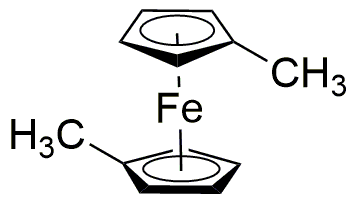1,1'-Dimethylferrocene is widely utilized in research focused on:
- Electrochemistry: This compound serves as a redox-active material in electrochemical sensors, enhancing the sensitivity and selectivity of detection methods for various analytes.
- Materials Science: It is incorporated into polymer composites to improve electrical conductivity, making it valuable in the development of advanced materials for electronics.
- Catalysis: The compound acts as a catalyst in organic reactions, facilitating processes such as hydrogenation and oxidation, which are crucial in the pharmaceutical industry.
- Nanotechnology: Used in the synthesis of ferrocene-based nanoparticles, it plays a key role in creating novel nanomaterials with applications in drug delivery and imaging.
- Organic Synthesis: It is a building block in the synthesis of various organic compounds, providing a versatile tool for chemists in developing new drugs and agrochemicals.
General Information
Properties
Safety and Regulations
Applications
1,1'-Dimethylferrocene is widely utilized in research focused on:
- Electrochemistry: This compound serves as a redox-active material in electrochemical sensors, enhancing the sensitivity and selectivity of detection methods for various analytes.
- Materials Science: It is incorporated into polymer composites to improve electrical conductivity, making it valuable in the development of advanced materials for electronics.
- Catalysis: The compound acts as a catalyst in organic reactions, facilitating processes such as hydrogenation and oxidation, which are crucial in the pharmaceutical industry.
- Nanotechnology: Used in the synthesis of ferrocene-based nanoparticles, it plays a key role in creating novel nanomaterials with applications in drug delivery and imaging.
- Organic Synthesis: It is a building block in the synthesis of various organic compounds, providing a versatile tool for chemists in developing new drugs and agrochemicals.
Documents
Safety Data Sheets (SDS)
The SDS provides comprehensive safety information on handling, storage, and disposal of the product.
Product Specification (PS)
The PS provides a comprehensive breakdown of the product’s properties, including chemical composition, physical state, purity, and storage requirements. It also details acceptable quality ranges and the product's intended applications.
Certificates of Analysis (COA)
Search for Certificates of Analysis (COA) by entering the products Lot Number. Lot and Batch Numbers can be found on a product’s label following the words ‘Lot’ or ‘Batch’.
Numéro de catalogue
Numéro de lot/série
Certificates Of Origin (COO)
This COO confirms the country where the product was manufactured, and also details the materials and components used in it and whether it is derived from natural, synthetic, or other specific sources. This certificate may be required for customs, trade, and regulatory compliance.
Numéro de catalogue
Numéro de lot/série
Safety Data Sheets (SDS)
The SDS provides comprehensive safety information on handling, storage, and disposal of the product.
DownloadProduct Specification (PS)
The PS provides a comprehensive breakdown of the product’s properties, including chemical composition, physical state, purity, and storage requirements. It also details acceptable quality ranges and the product's intended applications.
DownloadCertificates of Analysis (COA)
Search for Certificates of Analysis (COA) by entering the products Lot Number. Lot and Batch Numbers can be found on a product’s label following the words ‘Lot’ or ‘Batch’.
Numéro de catalogue
Numéro de lot/série
Certificates Of Origin (COO)
This COO confirms the country where the product was manufactured, and also details the materials and components used in it and whether it is derived from natural, synthetic, or other specific sources. This certificate may be required for customs, trade, and regulatory compliance.


